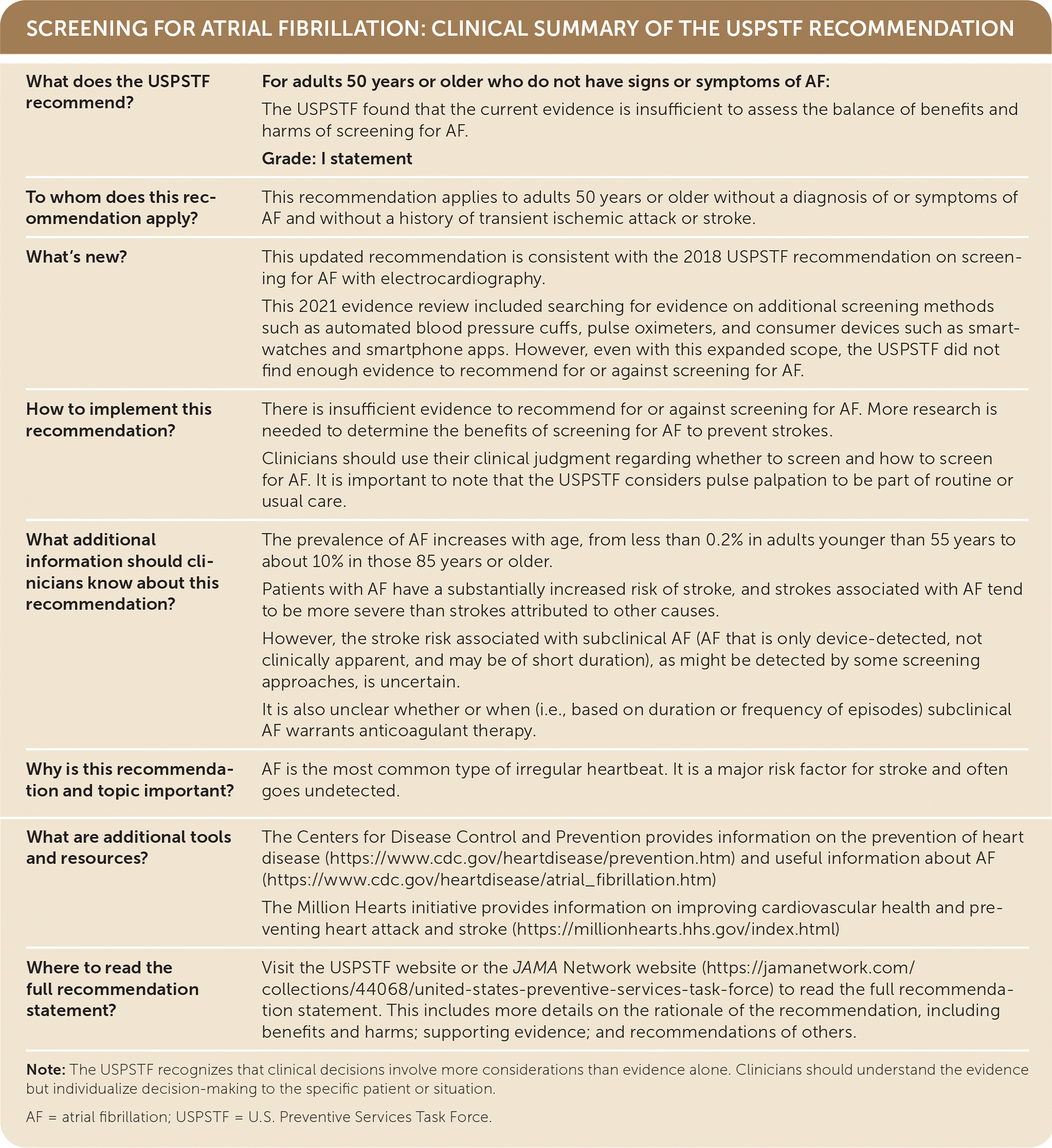
Am Fam Physician. 2022;105(6):online
Related Putting Prevention into Practice: Screening for Atrial Fibrillation
As published by the USPSTF.

| What does the USPSTF recommend? | For adults 50 years or older who do not have signs or symptoms of AF: The USPSTF found that the current evidence is insufficient to assess the balance of benefits and harms of screening for AF. Grade: I statement |
| To whom does this recommendation apply? | This recommendation applies to adults 50 years or older without a diagnosis of or symptoms of AF and without a history of transient ischemic attack or stroke. |
| What's new? | This updated recommendation is consistent with the 2018 USPSTF recommendation on screening for AF with electrocardiography. This 2021 evidence review included searching for evidence on additional screening methods such as automated blood pressure cuffs, pulse oximeters, and consumer devices such as smart-watches and smartphone apps. However, even with this expanded scope, the USPSTF did not find enough evidence to recommend for or against screening for AF. |
| How to implement this recommendation? | There is insufficient evidence to recommend for or against screening for AF. More research is needed to determine the benefits of screening for AF to prevent strokes. Clinicians should use their clinical judgment regarding whether to screen and how to screen for AF. It is important to note that the USPSTF considers pulse palpation to be part of routine or usual care. |
| What additional information should clinicians know about this recommendation? | The prevalence of AF increases with age, from less than 0.2% in adults younger than 55 years to about 10% in those 85 years or older. Patients with AF have a substantially increased risk of stroke, and strokes associated with AF tend to be more severe than strokes attributed to other causes. However, the stroke risk associated with subclinical AF (AF that is only device-detected, not clinically apparent, and may be of short duration), as might be detected by some screening approaches, is uncertain. It is also unclear whether or when (i.e., based on duration or frequency of episodes) subclinical AF warrants anticoagulant therapy. |
| Why is this recommendation and topic important? | AF is the most common type of irregular heartbeat. It is a major risk factor for stroke and often goes undetected. |
| What are additional tools and resources? | The Centers for Disease Control and Prevention provides information on the prevention of heart disease (https://www.cdc.gov/heartdisease/prevention.htm) and useful information about AF (https://www.cdc.gov/heartdisease/atrial_fibrillation.htm) The Million Hearts initiative provides information on improving cardiovascular health and preventing heart attack and stroke (https://millionhearts.hhs.gov/index.html) |
| Where to read the full recommendation statement? | Visit the USPSTF website or the JAMA Network website (https://jamanetwork.com/collections/44068/united-states-preventive-services-task-force) to read the full recommendation statement. This includes more details on the rationale of the recommendation, including benefits and harms; supporting evidence; and recommendations of others. |
This series is coordinated by Kenny Lin, MD, MPH, deputy editor.
A collection of USPSTF recommendation statements published in AFP is available at https://www.aafp.org/afp/uspstf.
The full recommendation statement is available at https://www.uspreventiveservicestaskforce.org/uspstf/recommendation/atrial-fibrillation-screening.
The USPSTF recommendations are independent of the U.S. government. They do not represent the views of the Agency for Healthcare Research and Quality, the U.S. Department of Health and Human Services, or the U.S. Public Health Service.
